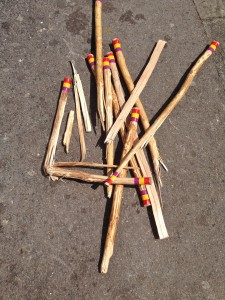
Nobody really knows how or where the morris began. But we quite like this imaginative version…
Morris Dancing was invented by Mr Morris Coppice of Painswick, near Stroud in Gloucestershire, shortly before the 1st of May 1419. This was according to that roguish English writer and commentator Sir Thomas Malory (c.1415 –1471), the author of Le Morte d’Arthur.
Morris Coppice was a horticulturalist by trade and spent long hours coppicing staves in the local woods to support his crop of runner beans. One night, whilst enjoying a ribald time in the local hooch house drinking quality local ales with his mates, he suggested that they did something different. Rather than just arguing about the Assizes of Bread and Ale, the carbon content of the soil and the vagaries of cow manure, or the 82 years’ war with France and whether the army would be back before Christmas, he proposed that they should dance. The lads decided to do some Celtic circle dancing until Morris interrupted and argued they do something instead with the shaved staves and the pack of crocheted hankies he had on him.
Thus Morris dancing was born and, coincidently, because Mr Coppice was a violent stick striker he got his nick name, Xylophagous Morris, eater of wood. Morris dancing soon became popular with the older chaps of the village once they discovered that they could earn lots of extra pennies from their dancing and that the ladies found them even more attractive in the tied smocks, military baldrics, bells and bloomers, that they wore to differentiate themselves from the ordinary yokels. Within a decade Morris Dancing had spread far and wide across the land and has been a cultural icon ever since.
How has morris changed in the 600 years since? Well, modern dancers look more stretched with the average height of a Brighton Morris man being 5 foot 10 inches compared with the aesthetically more pleasing 5 foot 3 inches of medieval times. The modern dancers are less likely to understand Greek and use nicknames like Shiny for bald headed members, or Trapper for those that regularly fail to clear the debris accumulating in their beards. Both medieval and modern chaps used or use pewter, wood, or bone, to sup ale, but neither spent much time bleaching their whites. Today the chaps are learning to be more respectful towards women but unfortunately the modern morris man has lost the art of crocheting thus their feminine side is somewhat skewed and their hankies are of cotton.
But for both ancient and modern it’s a xylophagous world.